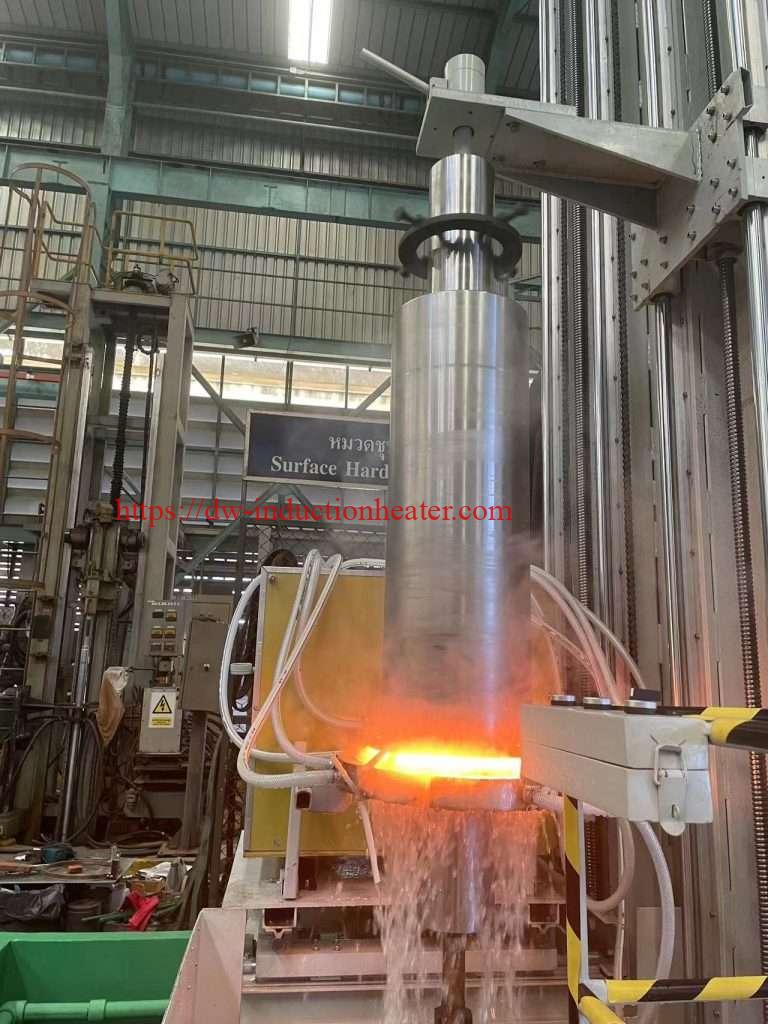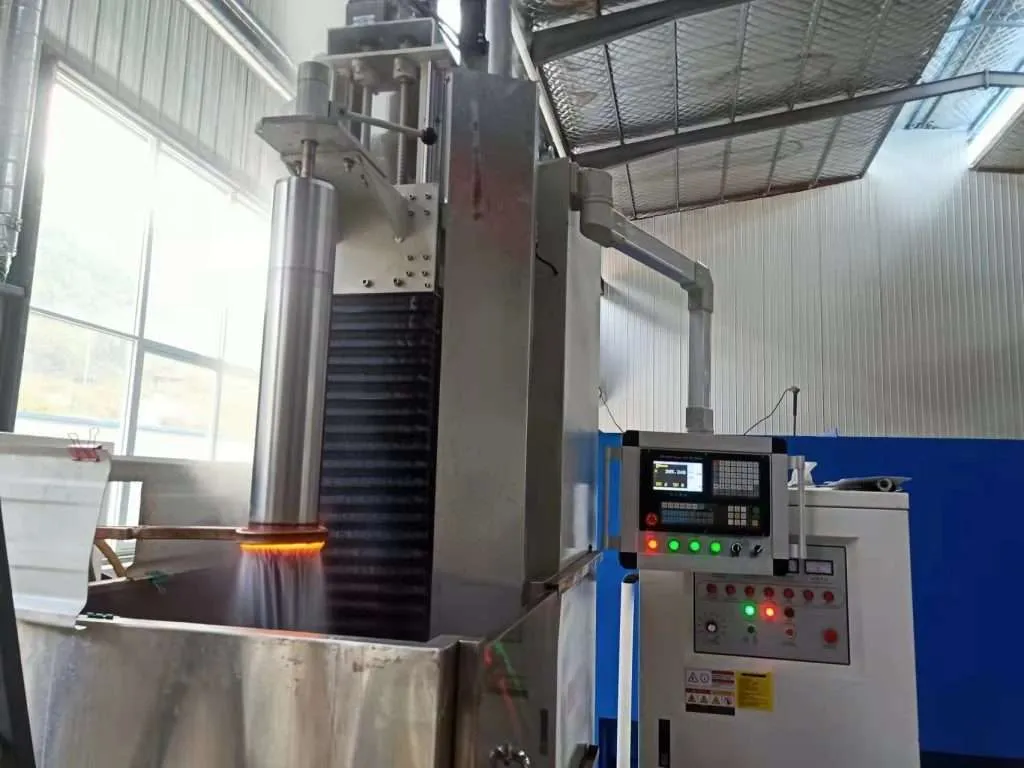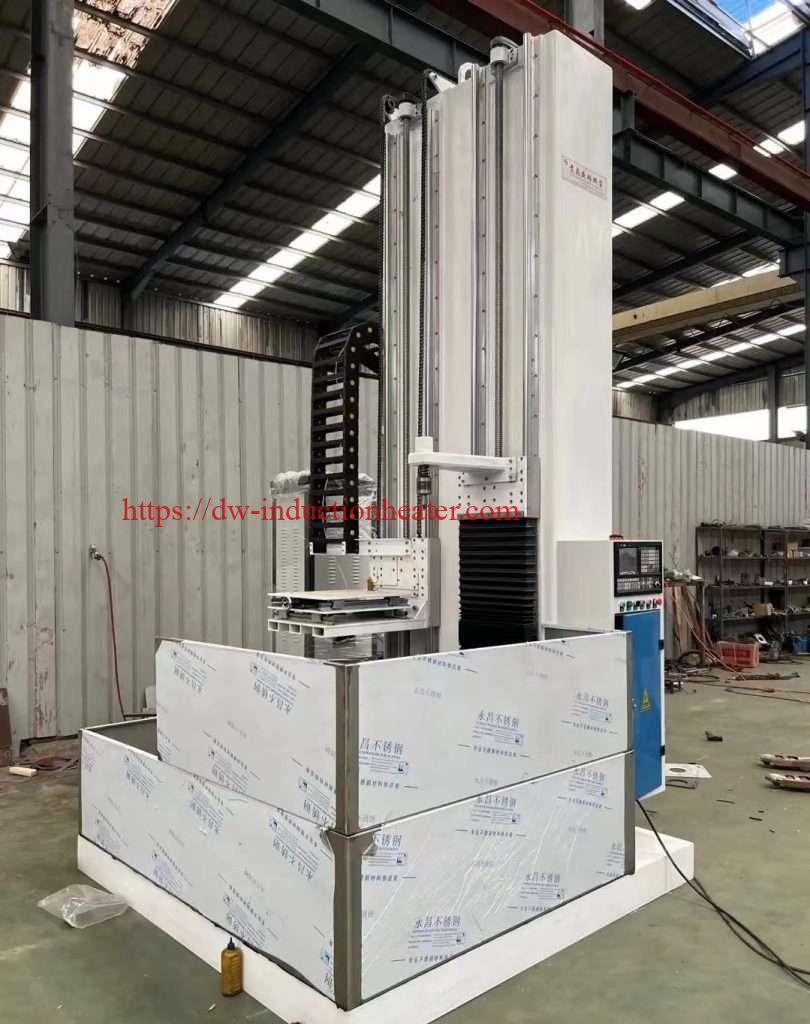
A
CNC /PLC Induction Vertical Hardening Scanner is an advanced tool designed for the precision hardening of specific parts of materials. These machines, equipped with features such as frequency control for targeted heating, are essential in industries that require precise hardening capabilities, such as the automotive sector for parts like steering racks. The technology allows for handling of materials up to 1 meter in length, with capabilities including PLC control and a colored HMI for ease of use. The vertical orientation of these scanners facilitates the hardening of longer parts, making them an invaluable asset for the complete heat-treatment procedure of a wide variety of materials.

Vertical hardening scanners represent a pivotal innovation in the field of materials science and heat treatment processes. This article delves into the intricacies of vertical
induction hardening scanners, exploring their evolution, technological advancements, and applications in various industries. By providing a comprehensive analysis, the text aims to elucidate the significance of these devices in improving the quality, efficiency, and precision of material hardening.
Introduction:
The induction hardening of materials, particularly metals, plays a critical role in various manufacturing processes. It involves the use of heat treatment to enhance the mechanical properties of a metal, such as its hardness, strength, and wear resistance. Traditional hardening methods often posed challenges in terms of uniformity and precision. However, the advent of vertical hardening scanners has revolutionized the process, offering greater control and consistency. This article examines the development and functionality of vertical hardening scanners, highlighting their i

mpact on the industry.
Historical Overview:
The concept of hardening metal dates back centuries, but it was the industrial revolution that necessitated more efficient and uniform hardening techniques. The earliest methods were manual and prone to human error, leading to inconsistencies in the final product. The need for improved precision and repeatability led to the development of mechanized hardening processes, setting the stage for the creation of vertical hardening scanners.
Technology and Mechanism:
Vertical hardening scanners are sophisticated devices that utilize a vertical, mechanized system to move parts through a precisely controlled heating and quenching process. They often incorporate induction heating, where an electromagnetic field generates heat within the metal workpiece without direct contact. This section of the article will explain the technical aspects of induction heating, the design of vertical scanners, and how they achieve uniform hardening across complex geometries.

Advancements and Innovations:
Over the years, vertical hardening scanners have seen substantial advancements. Innovations in control systems, such as computer numerical control (CNC) and programmable logic controllers (PLCs), have vastly improved the precision and repeatability of hardening cycles. Furthermore, developments in sensor technology and real-time monitoring have enabled better temperature control and process optimization. This part of the article will discuss the latest technological enhancements and their implications for the hardening process.
Applications in Industry:
Vertical hardening scanners have found applications across a myriad of industries, from automotive to aerospace and tool manufacturing. The ability to harden specific areas of a component, known as selective hardening, has been particularly beneficial in creating parts that require different mechanical properties in different regions. This segment will explore various case studies and industry-specific applications, illustrating the versatility and necessity of vertical hardening scanners in modern manufacturing.

Challenges and Future Outlook:
Despite the advancements, there are still challenges faced by vertical hardening scanners, such as the need for skilled operators and the limitations imposed by the size and shape of components. The future of vertical hardening scanners looks promising, with ongoing research and development in areas like automation, artificial intelligence, and the integration of Industry 4.0 technologies. This concluding section will provide an insightful forecast into the future developments and potential breakthroughs in vertical hardening scanner technology.
Technical Parameter
| Model |
SK-500 |
SK-1000 |
SK-1200 |
SK-1500 |
| Max heating length(mm) |
500 |
1000 |
1200 |
1500 |
| Max heating diameter(mm) |
500 |
500 |
600 |
600 |
| Max holding length(mm) |
600 |
1100 |
1300 |
1600 |
| Max weight of workpiece(Kg) |
100 |
100 |
100 |
100 |
| Workpiece rotation speed(r/min) |
0-300 |
0-300 |
0-300 |
0-300 |
| workpiece moving speed(mm/min) |
6-3000 |
6-3000 |
6-3000 |
6-3000 |
| Cooling method |
Hydrojet cooling |
Hydrojet cooling |
Hydrojet cooling |
Hydrojet cooling |
| Input voltage |
3P 380V 50Hz |
3P 380V 50Hz |
3P 380V 50Hz |
3P 380V 50Hz |
| Motor power |
1.1KW |
1.1KW |
1.2KW |
1.5KW |
| Dimension LxWxH (mm) |
1600 x800 x2000 |
1600 x800 x2400 |
1900 x900 x2900 |
1900 x900 x3200 |
| weight(Kg) |
800 |
900 |
1100 |
1200 |
| Model |
SK-2000 |
SK-2500 |
SK-3000 |
SK-4000 |
| Max heating length(mm) |
2000 |
2500 |
3000 |
4000 |
| Max heating diameter(mm) |
600 |
600 |
600 |
600 |
| Max holding length(mm) |
2000 |
2500 |
3000 |
4000 |
| Max weight of workpiece(Kg) |
800 |
1000 |
1200 |
1500 |
| workpiece rotation speed(r/min) |
0-300 |
0-300 |
0-300 |
0-300 |
| workpiece moving speed(mm/min) |
6-3000 |
6-3000 |
6-3000 |
6-3000 |
| Cooling method |
Hydrojet cooling |
Hydrojet cooling |
Hydrojet cooling |
Hydrojet cooling |
| Input voltage |
3P 380V 50Hz |
3P 380V 50Hz |
3P 380V 50Hz |
3P 380V 50Hz |
| Motor power |
2KW |
2.2KW |
2.5KW |
3KW |
| Dimension LxWxH (mm) |
1900 x900 x2400 |
1900 x900 x2900 |
1900 x900 x3400 |
1900 x900 x4300 |
| weight(Kg) |
1200 |
1300 |
1400 |
1500 |

Conclusion:
Induction Vertical hardening scanners have significantly influenced the way industries approach the hardening of materials. Through technological innovation and application-specific design, these devices have become integral to achieving high-quality, hardened components. As the demand for more advanced materials and complex geometries grows, vertical hardening scanners will continue to evolve, playing a critical role in meeting the challenges of tomorrow's manufacturing needs.
https://dw-inductionheater.com/the-evolution-and-advancements-in-vertical-hardening-scanner.html?feed_id=237224&_unique_id=65f8343f9d8ec
 A CNC /PLC Induction Vertical Hardening Scanner is an advanced tool designed for the precision hardening of specific parts of materials. These machines, equipped with features such as frequency control for targeted heating, are essential in industries that require precise hardening capabilities, such as the automotive sector for parts like steering racks. The technology allows for handling of materials up to 1 meter in length, with capabilities including PLC control and a colored HMI for ease of use. The vertical orientation of these scanners facilitates the hardening of longer parts, making them an invaluable asset for the complete heat-treatment procedure of a wide variety of materials.
A CNC /PLC Induction Vertical Hardening Scanner is an advanced tool designed for the precision hardening of specific parts of materials. These machines, equipped with features such as frequency control for targeted heating, are essential in industries that require precise hardening capabilities, such as the automotive sector for parts like steering racks. The technology allows for handling of materials up to 1 meter in length, with capabilities including PLC control and a colored HMI for ease of use. The vertical orientation of these scanners facilitates the hardening of longer parts, making them an invaluable asset for the complete heat-treatment procedure of a wide variety of materials. Vertical hardening scanners represent a pivotal innovation in the field of materials science and heat treatment processes. This article delves into the intricacies of vertical induction hardening scanners, exploring their evolution, technological advancements, and applications in various industries. By providing a comprehensive analysis, the text aims to elucidate the significance of these devices in improving the quality, efficiency, and precision of material hardening.
Introduction:
The induction hardening of materials, particularly metals, plays a critical role in various manufacturing processes. It involves the use of heat treatment to enhance the mechanical properties of a metal, such as its hardness, strength, and wear resistance. Traditional hardening methods often posed challenges in terms of uniformity and precision. However, the advent of vertical hardening scanners has revolutionized the process, offering greater control and consistency. This article examines the development and functionality of vertical hardening scanners, highlighting their i
Vertical hardening scanners represent a pivotal innovation in the field of materials science and heat treatment processes. This article delves into the intricacies of vertical induction hardening scanners, exploring their evolution, technological advancements, and applications in various industries. By providing a comprehensive analysis, the text aims to elucidate the significance of these devices in improving the quality, efficiency, and precision of material hardening.
Introduction:
The induction hardening of materials, particularly metals, plays a critical role in various manufacturing processes. It involves the use of heat treatment to enhance the mechanical properties of a metal, such as its hardness, strength, and wear resistance. Traditional hardening methods often posed challenges in terms of uniformity and precision. However, the advent of vertical hardening scanners has revolutionized the process, offering greater control and consistency. This article examines the development and functionality of vertical hardening scanners, highlighting their i mpact on the industry.
Historical Overview:
The concept of hardening metal dates back centuries, but it was the industrial revolution that necessitated more efficient and uniform hardening techniques. The earliest methods were manual and prone to human error, leading to inconsistencies in the final product. The need for improved precision and repeatability led to the development of mechanized hardening processes, setting the stage for the creation of vertical hardening scanners.
Technology and Mechanism:
Vertical hardening scanners are sophisticated devices that utilize a vertical, mechanized system to move parts through a precisely controlled heating and quenching process. They often incorporate induction heating, where an electromagnetic field generates heat within the metal workpiece without direct contact. This section of the article will explain the technical aspects of induction heating, the design of vertical scanners, and how they achieve uniform hardening across complex geometries.
mpact on the industry.
Historical Overview:
The concept of hardening metal dates back centuries, but it was the industrial revolution that necessitated more efficient and uniform hardening techniques. The earliest methods were manual and prone to human error, leading to inconsistencies in the final product. The need for improved precision and repeatability led to the development of mechanized hardening processes, setting the stage for the creation of vertical hardening scanners.
Technology and Mechanism:
Vertical hardening scanners are sophisticated devices that utilize a vertical, mechanized system to move parts through a precisely controlled heating and quenching process. They often incorporate induction heating, where an electromagnetic field generates heat within the metal workpiece without direct contact. This section of the article will explain the technical aspects of induction heating, the design of vertical scanners, and how they achieve uniform hardening across complex geometries. Advancements and Innovations:
Over the years, vertical hardening scanners have seen substantial advancements. Innovations in control systems, such as computer numerical control (CNC) and programmable logic controllers (PLCs), have vastly improved the precision and repeatability of hardening cycles. Furthermore, developments in sensor technology and real-time monitoring have enabled better temperature control and process optimization. This part of the article will discuss the latest technological enhancements and their implications for the hardening process.
Applications in Industry:
Vertical hardening scanners have found applications across a myriad of industries, from automotive to aerospace and tool manufacturing. The ability to harden specific areas of a component, known as selective hardening, has been particularly beneficial in creating parts that require different mechanical properties in different regions. This segment will explore various case studies and industry-specific applications, illustrating the versatility and necessity of vertical hardening scanners in modern manufacturing.
Advancements and Innovations:
Over the years, vertical hardening scanners have seen substantial advancements. Innovations in control systems, such as computer numerical control (CNC) and programmable logic controllers (PLCs), have vastly improved the precision and repeatability of hardening cycles. Furthermore, developments in sensor technology and real-time monitoring have enabled better temperature control and process optimization. This part of the article will discuss the latest technological enhancements and their implications for the hardening process.
Applications in Industry:
Vertical hardening scanners have found applications across a myriad of industries, from automotive to aerospace and tool manufacturing. The ability to harden specific areas of a component, known as selective hardening, has been particularly beneficial in creating parts that require different mechanical properties in different regions. This segment will explore various case studies and industry-specific applications, illustrating the versatility and necessity of vertical hardening scanners in modern manufacturing. Challenges and Future Outlook:
Despite the advancements, there are still challenges faced by vertical hardening scanners, such as the need for skilled operators and the limitations imposed by the size and shape of components. The future of vertical hardening scanners looks promising, with ongoing research and development in areas like automation, artificial intelligence, and the integration of Industry 4.0 technologies. This concluding section will provide an insightful forecast into the future developments and potential breakthroughs in vertical hardening scanner technology.
Technical Parameter
Challenges and Future Outlook:
Despite the advancements, there are still challenges faced by vertical hardening scanners, such as the need for skilled operators and the limitations imposed by the size and shape of components. The future of vertical hardening scanners looks promising, with ongoing research and development in areas like automation, artificial intelligence, and the integration of Industry 4.0 technologies. This concluding section will provide an insightful forecast into the future developments and potential breakthroughs in vertical hardening scanner technology.
Technical Parameter
 Conclusion:
Induction Vertical hardening scanners have significantly influenced the way industries approach the hardening of materials. Through technological innovation and application-specific design, these devices have become integral to achieving high-quality, hardened components. As the demand for more advanced materials and complex geometries grows, vertical hardening scanners will continue to evolve, playing a critical role in meeting the challenges of tomorrow's manufacturing needs.
https://dw-inductionheater.com/the-evolution-and-advancements-in-vertical-hardening-scanner.html?feed_id=237224&_unique_id=65f8343f9d8ec
Conclusion:
Induction Vertical hardening scanners have significantly influenced the way industries approach the hardening of materials. Through technological innovation and application-specific design, these devices have become integral to achieving high-quality, hardened components. As the demand for more advanced materials and complex geometries grows, vertical hardening scanners will continue to evolve, playing a critical role in meeting the challenges of tomorrow's manufacturing needs.
https://dw-inductionheater.com/the-evolution-and-advancements-in-vertical-hardening-scanner.html?feed_id=237224&_unique_id=65f8343f9d8ec
